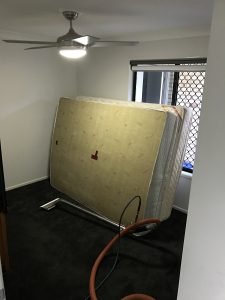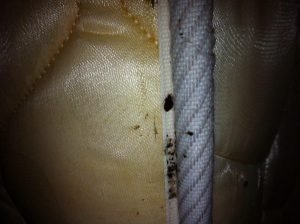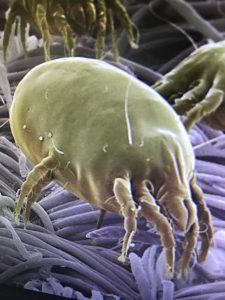What’s the difference between Bedbugs and Dust Mites?
What’s the difference between bedbugs and dust mites? (Pricing Click Here)
Ok before we start on the differences between the bedbug and the dust mite and how to identify which one you may have a problem with, let me explain a bit about me.
I’ve been working in the pest control industry now for a bit over 20 years and have seen my fair share of pests from cockroaches to bedbugs and everything else in-between, and I’ve also done my fair share of treatment for both bedbugs and dust mites, so I’m pretty well qualified in this areas.
So let’s start with some basics on both pests, starting with bedbugs.
Bedbugs are one of the hardest pests to get rid of from your home, as you can see in the picture, they are fairly big, not as big as a cockroach, but they are big enough for you to see them roaming around your bed or more preciously your mattress, they are about 4-5mm long. (See picture below)
Both male and female adults and nymphs are blood suckers, so from the moment they hatch they require blood to survive, and your blood at that.
They feed on the blood of the person unfortunate enough to be sleeping in the bed they are harbouring in; they come out to feed during the early hours of the night and stay hidden during the day.
The occupant of the bed doesn’t know they have been bitten until the next day, and usually there will be blood spots on the bed sheets after the bedbugs have fed.
If there are two people sleeping in the bed, it is common for just one person to be bitten and the other not have any sign’s what so ever of any bits or issues from them, and I have seen this many times with customers that I have done a bedbugs treatment for, the higher temperature of the host helps the bedbugs to locate and feed from them, the host being you.
Dust Mites
Ok now a little on the dust mites, firstly they are a microscopic little pest, so we can’t see them but at times we can feel the results of them from skin irritations.
Even the cleanest of homes can have a problem with dust mites, but it is more common in homes that are not vacuumed on a regular basis, to help avoid any problems you should be vacuuming at least 3 times per week, that is the Australian standard, but as I say to my customer this will depend on the location of your home and the amount of people and pets living there, take my house for instance we vacuum on a daily basis.
Dust mites are everywhere and cannot be totally eradicated no matter how hard we try.
They harbour in mattresses, bedding sheets, upholstered seats etc. and are at their most prolific during times of high humidity.
Dust mites feed on flakes of skin that shed on a daily basis from people and pets.
There really isn’t a lot more to know about dust mites, but if you have a problems with them, regular vacuuming is key to help in controlling them.
How to tell which you have (Dust Mites) or (Bedbugs)
Many customers get it wrong as to what they have a problem with, i.e. bedbugs or dust mites, most presume straightaway that it’s bedbugs, this may be because if you do a google search this is the thing that comes up most of all.
The way to determine what you have a problem with is to firstly do an inspection of the rooms where you are getting bitten.
If your problem is with bedbugs for instance then the problem is most likely to be in the bedroom, so an inspection of this area is important, although bedbugs can still harbour in other rooms and items of furniture such as lounge suites.
Starting with the bed, which is obvious if you have read from the start of this blog, the bed is where you are most likely going to find bedbugs.
They will typically be harbouring around the edges of the mattress, under the pleats where the top and sides are stitched together, this is the first place I look at when going out to do a bedbugs treatment.
Also a thorough inspection of the bed base and the shirting boards or even behind pictures hanging on the walls, they can harbour there also.
If you can’t see any signs of a bedbug in these areas, and trust me if they are there you will see them, some people think they are microscopic, but they are not they are very visible to the human eye, and if there is an infestation the mattress will be crawling with them.
Another tell-tale sign is bites and irritation around the bites, and also you will see blood spots on the bed sheets as mentioned earlier.
Finally if you are getting none of this and you can’t see any then you probably don’t have them, and then we can start looking at Dust Mites.
Now with dust mites these little critters are microscopic, so they are not visible to the human eye.
They will give you irritable skin and sometimes with excess starching you may end up making an area of skin bleed, and this is then what makes some people think their problem is with bedbugs, but it may just have been caused by yourself.
It is very easy to get confused between the two, but for me as a licensed pest control technician I can tell within about 10 to 15 minutes of being in the house if the problem is with dust mites or bedbugs.
The reason I can tell is this, firstly I would ask the customer, which rooms they feel the problem is in, if they say a bedroom, then I’ll go and do my inspection there first.
Now when I start to look at the bed and lift the sheets back etc., I am disturbing the environment in which both the bedbugs and dust mites harbour in, so if there are bedbugs for instance I am most likely going to see them hiding in and around the mattress and bedding.
If there are no bedbugs then I will disturb the dust mites, and pretty much straightaway I will start to feel some skin irritation from being in and around the area that the dust mites are harbouring in.
So just to recap, if there are bedbugs we will see them in the problem areas described above, if there are dust mites then a skin irritation will start once you disturb their environment, and this is how I tell which pest I am dealing with in a very short time of being at the premises with the problem.
How to get rid of (Dust Mites) and (Bedbugs)
The one good thing is the treatment for both of these pests is pretty much the same.
If you call out a company that only deals in pest control, then you may not get rid of them as effectively as a company that does both carpet and upholstery cleaning and pest control at the same time.
The reason I say this is because I have done these types of treatments in the past and have found that by doing just a chemical treatment, the problem can persist.
Whereas the treatments I have done where we have done both a deep steam clean of the effected items, such as mattresses, rugs, carpets, seats etc. and then also done a chemical treatment, the effects have been much more successful.
So you can either go with just the chemical treatment or do both from the start, and do the clean at the same time as the chemical treatment, that choice is yours to make.
The Treatment.
So when we are called out to one of these jobs, we firstly do the steam clean, this in my eyes gives us a clean slate to work with, all of the edges of the carpets are also cleaned using a crevice tool that attaches to the steam cleaner.
Once all of the areas are cleaned that need to be cleaned we then start the chemical treatment.
So all cracks and grieves are sprayed, this includes all the edges of carpets where they meet the skirting boards, under any other furniture in the room, and especially the bed.
The bed frame and mattress gets treated paying attention to the mattress edges, because as explain earlier in this blog this is where bedbugs will harbour and breed.
In the picture below is the finished room of a job we did that the customer thought had bedbugs, but in fact it turned out to be a dust mite problem, as you can see all of the bed and carpets have been thoroughly cleaned and treated, including the shirting boards and any cracks and crevices in the room.
In my opinion this is the only way to treat for any of these types of pest.

Treated Room

Bedbugs infesting a mattress.

Adult Bed bug (Cimex lectularius)

Dust Mite













































Leave a Reply
Want to join the discussion?Feel free to contribute!